Charles Sturt University: Early Launch Scenario 3, Ethics Assignment
VerifiedAdded on 2020/03/07
|7
|2107
|68
Homework Assignment
AI Summary
This assignment analyzes the 'Early Launch' scenario, focusing on ethical dilemmas faced by an IT firm regarding the early delivery of a software project. Using the 'Doing Ethics Technique', the assignment dissects the scenario, identifying non-ethical and ethical issues, and the stakeholders involved. It explores the implications of delivering a software product without encryption, potentially compromising user data and the company's reputation. The analysis evaluates various options, including delivering the project on time with encryption, and concludes that prioritizing ethical considerations, such as software encryption, is the best approach to ensure data security, maintain user trust, and safeguard the company's reputation and long-term growth. The assignment underscores the importance of ethical decision-making in project management and the IT industry.
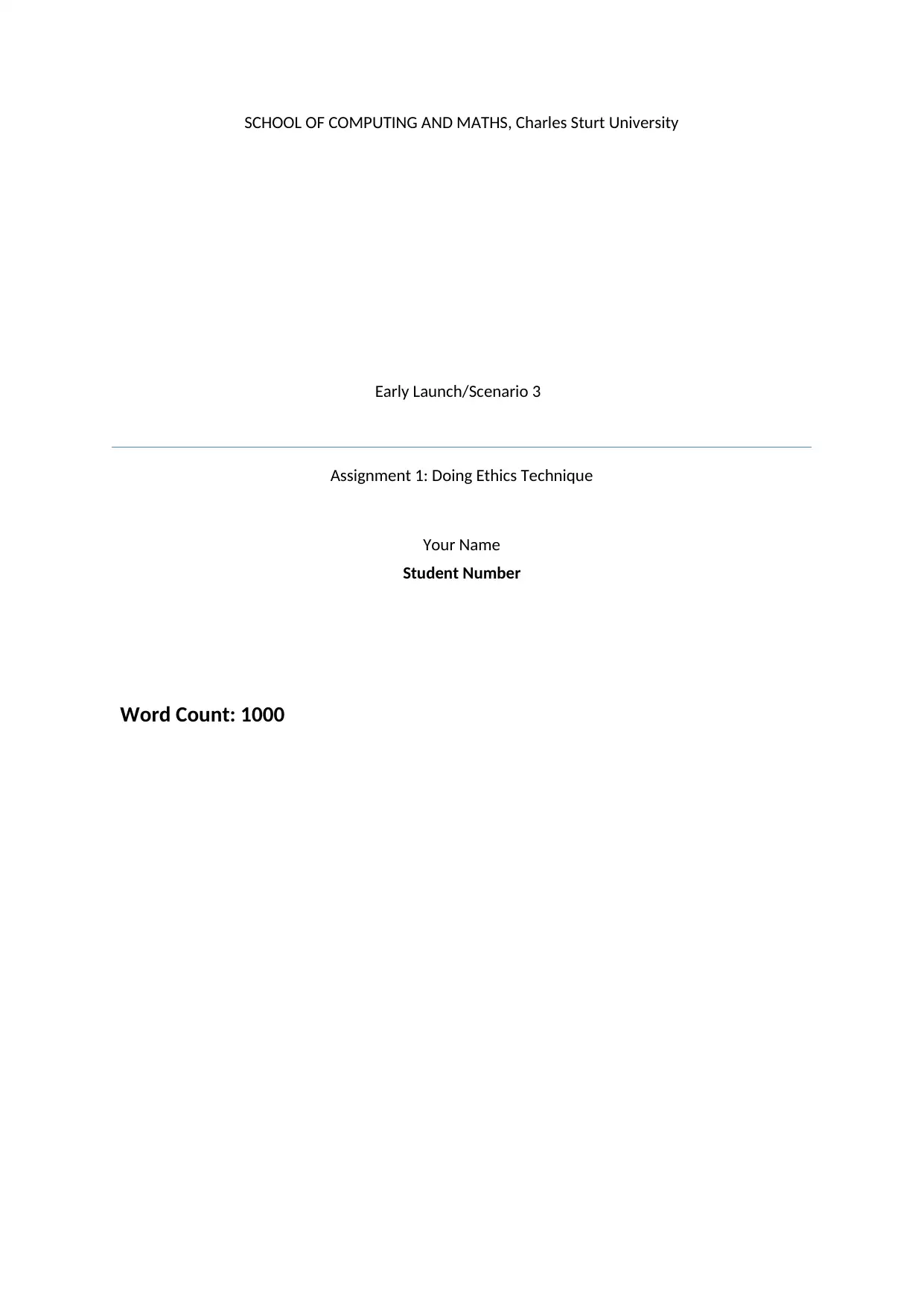
SCHOOL OF COMPUTING AND MATHS, Charles Sturt University
Early Launch/Scenario 3
Assignment 1: Doing Ethics Technique
Your Name
Student Number
Word Count: 1000
Early Launch/Scenario 3
Assignment 1: Doing Ethics Technique
Your Name
Student Number
Word Count: 1000
Paraphrase This Document
Need a fresh take? Get an instant paraphrase of this document with our AI Paraphraser
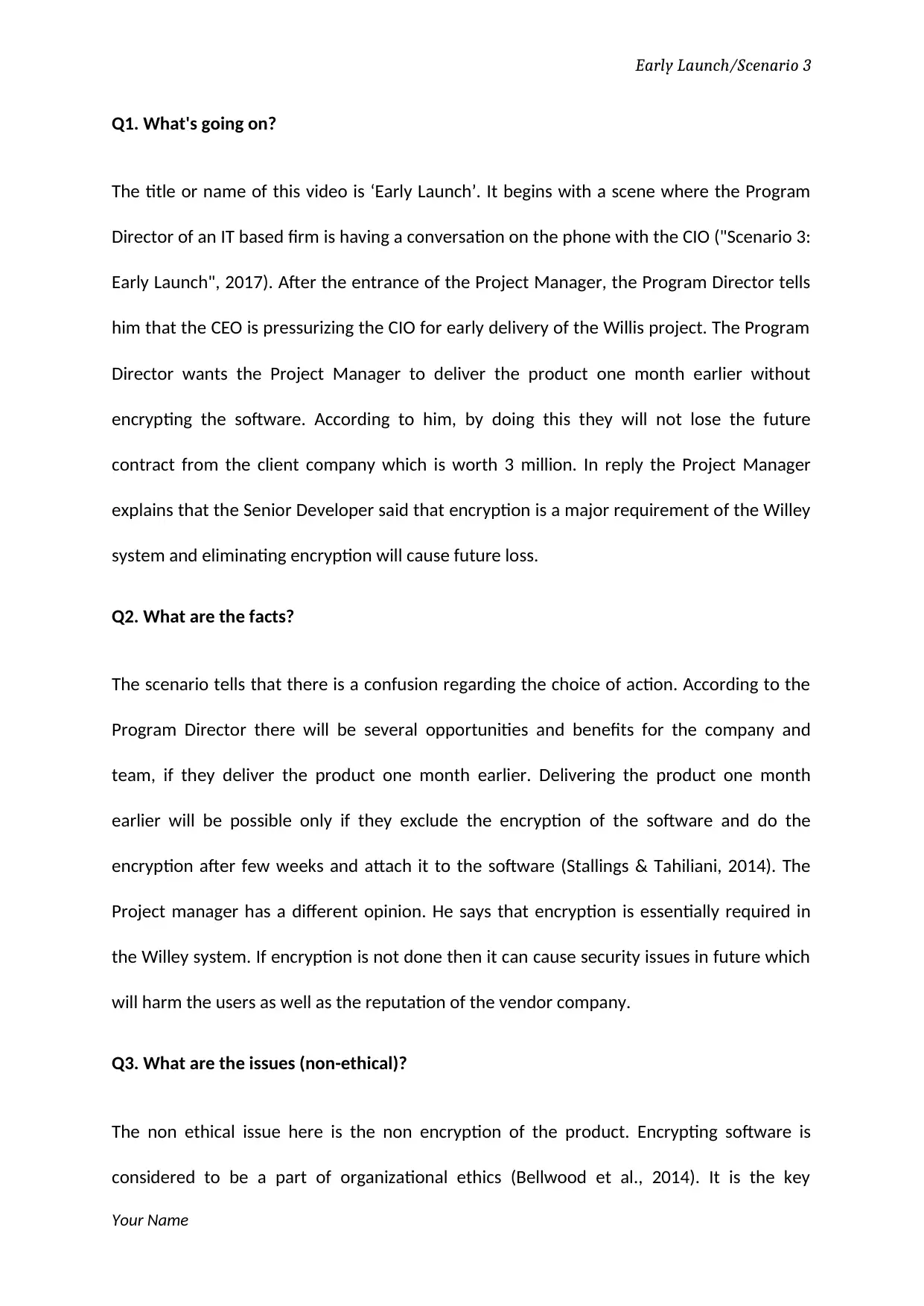
Early Launch/Scenario 3
Q1. What's going on?
The title or name of this video is ‘Early Launch’. It begins with a scene where the Program
Director of an IT based firm is having a conversation on the phone with the CIO ("Scenario 3:
Early Launch", 2017). After the entrance of the Project Manager, the Program Director tells
him that the CEO is pressurizing the CIO for early delivery of the Willis project. The Program
Director wants the Project Manager to deliver the product one month earlier without
encrypting the software. According to him, by doing this they will not lose the future
contract from the client company which is worth 3 million. In reply the Project Manager
explains that the Senior Developer said that encryption is a major requirement of the Willey
system and eliminating encryption will cause future loss.
Q2. What are the facts?
The scenario tells that there is a confusion regarding the choice of action. According to the
Program Director there will be several opportunities and benefits for the company and
team, if they deliver the product one month earlier. Delivering the product one month
earlier will be possible only if they exclude the encryption of the software and do the
encryption after few weeks and attach it to the software (Stallings & Tahiliani, 2014). The
Project manager has a different opinion. He says that encryption is essentially required in
the Willey system. If encryption is not done then it can cause security issues in future which
will harm the users as well as the reputation of the vendor company.
Q3. What are the issues (non-ethical)?
The non ethical issue here is the non encryption of the product. Encrypting software is
considered to be a part of organizational ethics (Bellwood et al., 2014). It is the key
Your Name
Q1. What's going on?
The title or name of this video is ‘Early Launch’. It begins with a scene where the Program
Director of an IT based firm is having a conversation on the phone with the CIO ("Scenario 3:
Early Launch", 2017). After the entrance of the Project Manager, the Program Director tells
him that the CEO is pressurizing the CIO for early delivery of the Willis project. The Program
Director wants the Project Manager to deliver the product one month earlier without
encrypting the software. According to him, by doing this they will not lose the future
contract from the client company which is worth 3 million. In reply the Project Manager
explains that the Senior Developer said that encryption is a major requirement of the Willey
system and eliminating encryption will cause future loss.
Q2. What are the facts?
The scenario tells that there is a confusion regarding the choice of action. According to the
Program Director there will be several opportunities and benefits for the company and
team, if they deliver the product one month earlier. Delivering the product one month
earlier will be possible only if they exclude the encryption of the software and do the
encryption after few weeks and attach it to the software (Stallings & Tahiliani, 2014). The
Project manager has a different opinion. He says that encryption is essentially required in
the Willey system. If encryption is not done then it can cause security issues in future which
will harm the users as well as the reputation of the vendor company.
Q3. What are the issues (non-ethical)?
The non ethical issue here is the non encryption of the product. Encrypting software is
considered to be a part of organizational ethics (Bellwood et al., 2014). It is the key
Your Name
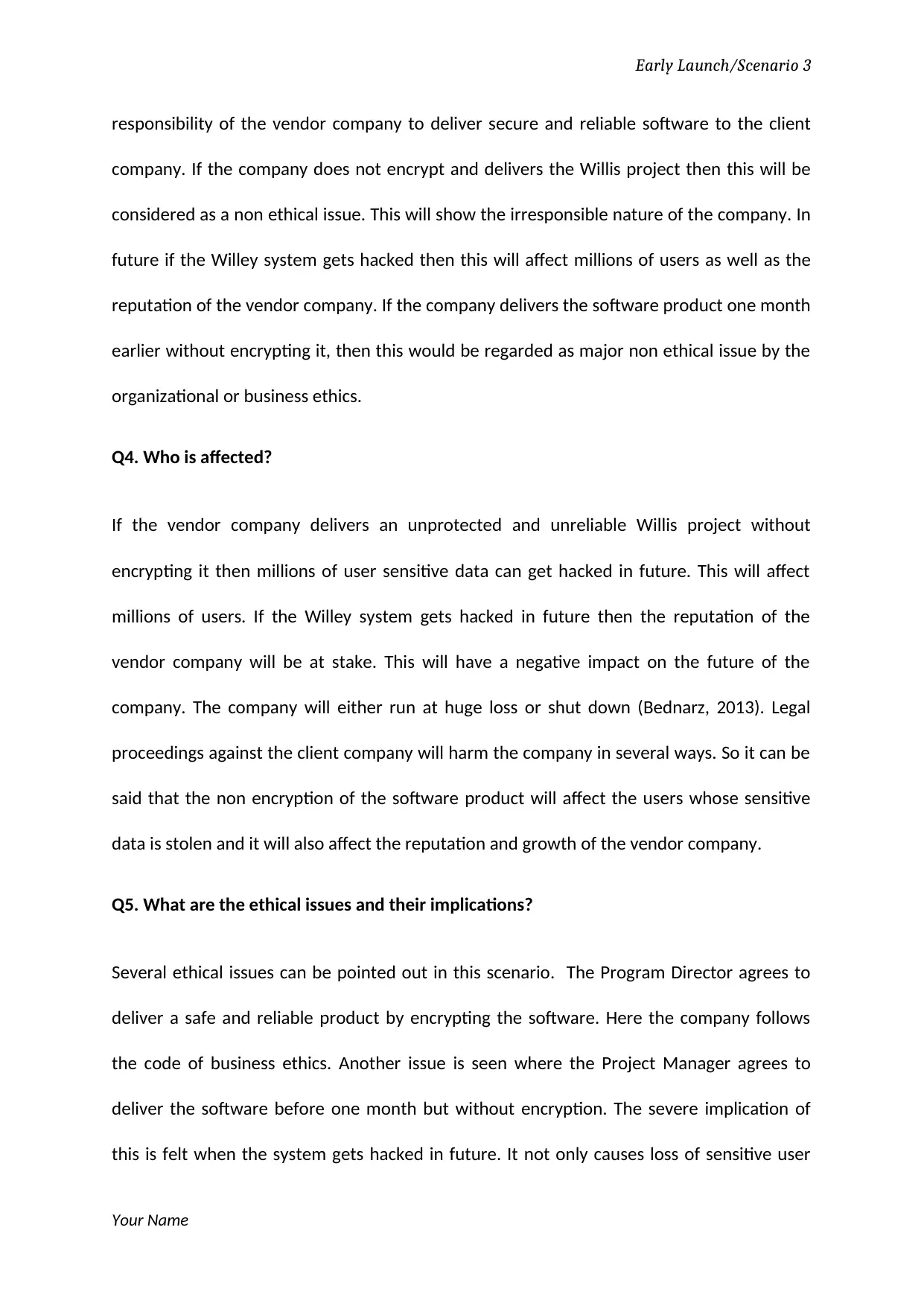
Early Launch/Scenario 3
responsibility of the vendor company to deliver secure and reliable software to the client
company. If the company does not encrypt and delivers the Willis project then this will be
considered as a non ethical issue. This will show the irresponsible nature of the company. In
future if the Willey system gets hacked then this will affect millions of users as well as the
reputation of the vendor company. If the company delivers the software product one month
earlier without encrypting it, then this would be regarded as major non ethical issue by the
organizational or business ethics.
Q4. Who is affected?
If the vendor company delivers an unprotected and unreliable Willis project without
encrypting it then millions of user sensitive data can get hacked in future. This will affect
millions of users. If the Willey system gets hacked in future then the reputation of the
vendor company will be at stake. This will have a negative impact on the future of the
company. The company will either run at huge loss or shut down (Bednarz, 2013). Legal
proceedings against the client company will harm the company in several ways. So it can be
said that the non encryption of the software product will affect the users whose sensitive
data is stolen and it will also affect the reputation and growth of the vendor company.
Q5. What are the ethical issues and their implications?
Several ethical issues can be pointed out in this scenario. The Program Director agrees to
deliver a safe and reliable product by encrypting the software. Here the company follows
the code of business ethics. Another issue is seen where the Project Manager agrees to
deliver the software before one month but without encryption. The severe implication of
this is felt when the system gets hacked in future. It not only causes loss of sensitive user
Your Name
responsibility of the vendor company to deliver secure and reliable software to the client
company. If the company does not encrypt and delivers the Willis project then this will be
considered as a non ethical issue. This will show the irresponsible nature of the company. In
future if the Willey system gets hacked then this will affect millions of users as well as the
reputation of the vendor company. If the company delivers the software product one month
earlier without encrypting it, then this would be regarded as major non ethical issue by the
organizational or business ethics.
Q4. Who is affected?
If the vendor company delivers an unprotected and unreliable Willis project without
encrypting it then millions of user sensitive data can get hacked in future. This will affect
millions of users. If the Willey system gets hacked in future then the reputation of the
vendor company will be at stake. This will have a negative impact on the future of the
company. The company will either run at huge loss or shut down (Bednarz, 2013). Legal
proceedings against the client company will harm the company in several ways. So it can be
said that the non encryption of the software product will affect the users whose sensitive
data is stolen and it will also affect the reputation and growth of the vendor company.
Q5. What are the ethical issues and their implications?
Several ethical issues can be pointed out in this scenario. The Program Director agrees to
deliver a safe and reliable product by encrypting the software. Here the company follows
the code of business ethics. Another issue is seen where the Project Manager agrees to
deliver the software before one month but without encryption. The severe implication of
this is felt when the system gets hacked in future. It not only causes loss of sensitive user
Your Name
⊘ This is a preview!⊘
Do you want full access?
Subscribe today to unlock all pages.

Trusted by 1+ million students worldwide
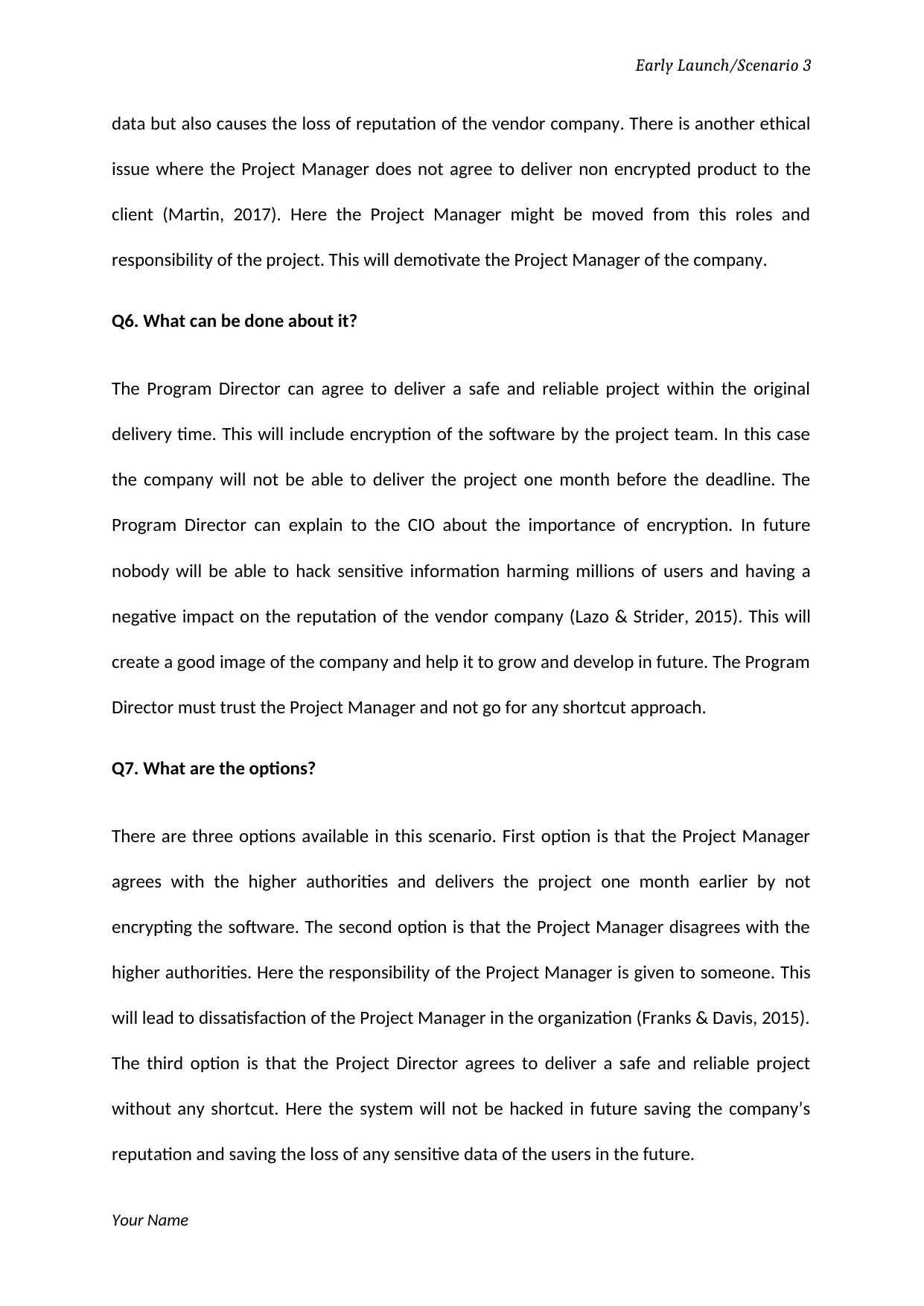
Early Launch/Scenario 3
data but also causes the loss of reputation of the vendor company. There is another ethical
issue where the Project Manager does not agree to deliver non encrypted product to the
client (Martin, 2017). Here the Project Manager might be moved from this roles and
responsibility of the project. This will demotivate the Project Manager of the company.
Q6. What can be done about it?
The Program Director can agree to deliver a safe and reliable project within the original
delivery time. This will include encryption of the software by the project team. In this case
the company will not be able to deliver the project one month before the deadline. The
Program Director can explain to the CIO about the importance of encryption. In future
nobody will be able to hack sensitive information harming millions of users and having a
negative impact on the reputation of the vendor company (Lazo & Strider, 2015). This will
create a good image of the company and help it to grow and develop in future. The Program
Director must trust the Project Manager and not go for any shortcut approach.
Q7. What are the options?
There are three options available in this scenario. First option is that the Project Manager
agrees with the higher authorities and delivers the project one month earlier by not
encrypting the software. The second option is that the Project Manager disagrees with the
higher authorities. Here the responsibility of the Project Manager is given to someone. This
will lead to dissatisfaction of the Project Manager in the organization (Franks & Davis, 2015).
The third option is that the Project Director agrees to deliver a safe and reliable project
without any shortcut. Here the system will not be hacked in future saving the company’s
reputation and saving the loss of any sensitive data of the users in the future.
Your Name
data but also causes the loss of reputation of the vendor company. There is another ethical
issue where the Project Manager does not agree to deliver non encrypted product to the
client (Martin, 2017). Here the Project Manager might be moved from this roles and
responsibility of the project. This will demotivate the Project Manager of the company.
Q6. What can be done about it?
The Program Director can agree to deliver a safe and reliable project within the original
delivery time. This will include encryption of the software by the project team. In this case
the company will not be able to deliver the project one month before the deadline. The
Program Director can explain to the CIO about the importance of encryption. In future
nobody will be able to hack sensitive information harming millions of users and having a
negative impact on the reputation of the vendor company (Lazo & Strider, 2015). This will
create a good image of the company and help it to grow and develop in future. The Program
Director must trust the Project Manager and not go for any shortcut approach.
Q7. What are the options?
There are three options available in this scenario. First option is that the Project Manager
agrees with the higher authorities and delivers the project one month earlier by not
encrypting the software. The second option is that the Project Manager disagrees with the
higher authorities. Here the responsibility of the Project Manager is given to someone. This
will lead to dissatisfaction of the Project Manager in the organization (Franks & Davis, 2015).
The third option is that the Project Director agrees to deliver a safe and reliable project
without any shortcut. Here the system will not be hacked in future saving the company’s
reputation and saving the loss of any sensitive data of the users in the future.
Your Name
Paraphrase This Document
Need a fresh take? Get an instant paraphrase of this document with our AI Paraphraser
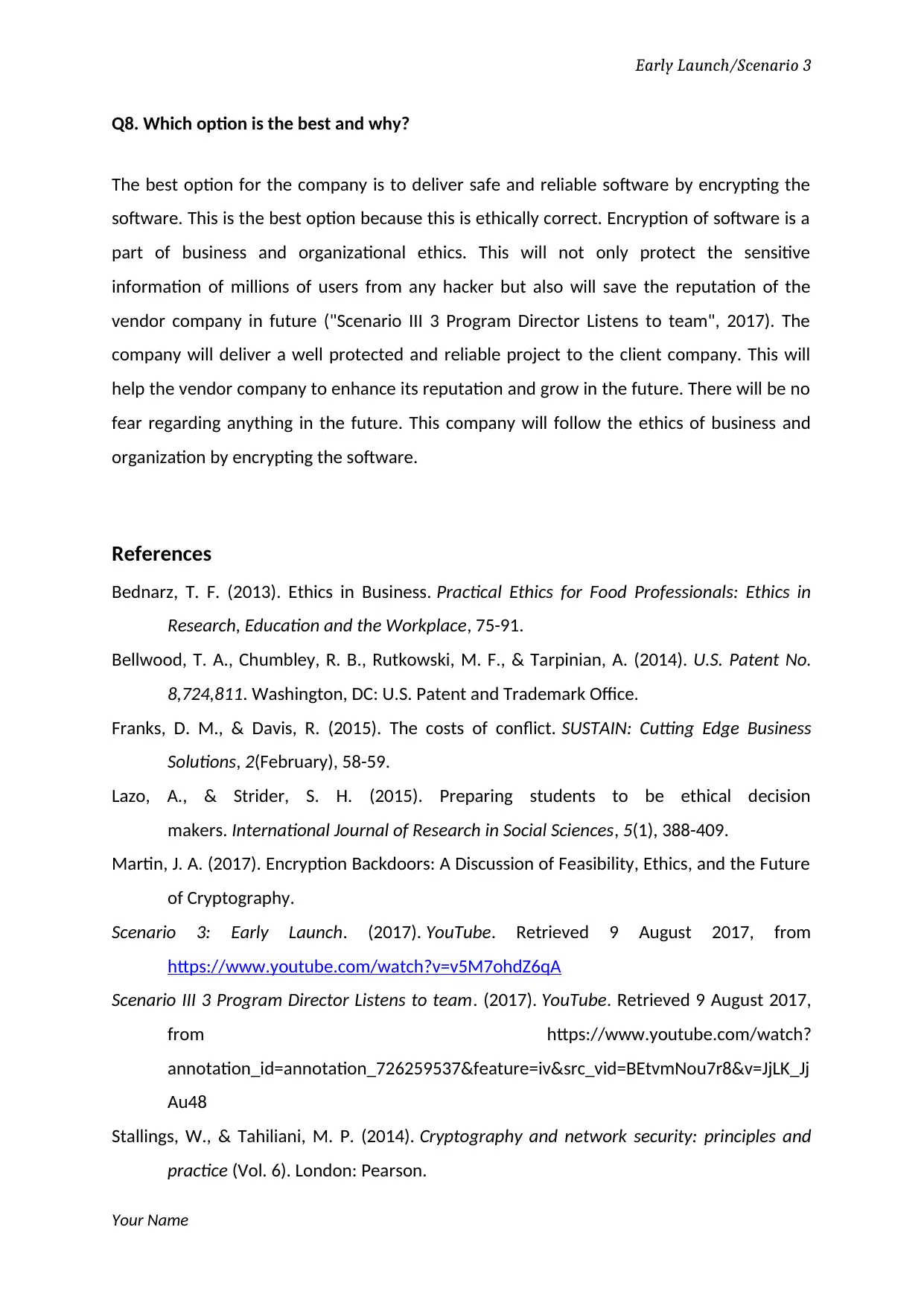
Early Launch/Scenario 3
Q8. Which option is the best and why?
The best option for the company is to deliver safe and reliable software by encrypting the
software. This is the best option because this is ethically correct. Encryption of software is a
part of business and organizational ethics. This will not only protect the sensitive
information of millions of users from any hacker but also will save the reputation of the
vendor company in future ("Scenario III 3 Program Director Listens to team", 2017). The
company will deliver a well protected and reliable project to the client company. This will
help the vendor company to enhance its reputation and grow in the future. There will be no
fear regarding anything in the future. This company will follow the ethics of business and
organization by encrypting the software.
References
Bednarz, T. F. (2013). Ethics in Business. Practical Ethics for Food Professionals: Ethics in
Research, Education and the Workplace, 75-91.
Bellwood, T. A., Chumbley, R. B., Rutkowski, M. F., & Tarpinian, A. (2014). U.S. Patent No.
8,724,811. Washington, DC: U.S. Patent and Trademark Office.
Franks, D. M., & Davis, R. (2015). The costs of conflict. SUSTAIN: Cutting Edge Business
Solutions, 2(February), 58-59.
Lazo, A., & Strider, S. H. (2015). Preparing students to be ethical decision
makers. International Journal of Research in Social Sciences, 5(1), 388-409.
Martin, J. A. (2017). Encryption Backdoors: A Discussion of Feasibility, Ethics, and the Future
of Cryptography.
Scenario 3: Early Launch. (2017). YouTube. Retrieved 9 August 2017, from
https://www.youtube.com/watch?v=v5M7ohdZ6qA
Scenario III 3 Program Director Listens to team. (2017). YouTube. Retrieved 9 August 2017,
from https://www.youtube.com/watch?
annotation_id=annotation_726259537&feature=iv&src_vid=BEtvmNou7r8&v=JjLK_Jj
Au48
Stallings, W., & Tahiliani, M. P. (2014). Cryptography and network security: principles and
practice (Vol. 6). London: Pearson.
Your Name
Q8. Which option is the best and why?
The best option for the company is to deliver safe and reliable software by encrypting the
software. This is the best option because this is ethically correct. Encryption of software is a
part of business and organizational ethics. This will not only protect the sensitive
information of millions of users from any hacker but also will save the reputation of the
vendor company in future ("Scenario III 3 Program Director Listens to team", 2017). The
company will deliver a well protected and reliable project to the client company. This will
help the vendor company to enhance its reputation and grow in the future. There will be no
fear regarding anything in the future. This company will follow the ethics of business and
organization by encrypting the software.
References
Bednarz, T. F. (2013). Ethics in Business. Practical Ethics for Food Professionals: Ethics in
Research, Education and the Workplace, 75-91.
Bellwood, T. A., Chumbley, R. B., Rutkowski, M. F., & Tarpinian, A. (2014). U.S. Patent No.
8,724,811. Washington, DC: U.S. Patent and Trademark Office.
Franks, D. M., & Davis, R. (2015). The costs of conflict. SUSTAIN: Cutting Edge Business
Solutions, 2(February), 58-59.
Lazo, A., & Strider, S. H. (2015). Preparing students to be ethical decision
makers. International Journal of Research in Social Sciences, 5(1), 388-409.
Martin, J. A. (2017). Encryption Backdoors: A Discussion of Feasibility, Ethics, and the Future
of Cryptography.
Scenario 3: Early Launch. (2017). YouTube. Retrieved 9 August 2017, from
https://www.youtube.com/watch?v=v5M7ohdZ6qA
Scenario III 3 Program Director Listens to team. (2017). YouTube. Retrieved 9 August 2017,
from https://www.youtube.com/watch?
annotation_id=annotation_726259537&feature=iv&src_vid=BEtvmNou7r8&v=JjLK_Jj
Au48
Stallings, W., & Tahiliani, M. P. (2014). Cryptography and network security: principles and
practice (Vol. 6). London: Pearson.
Your Name
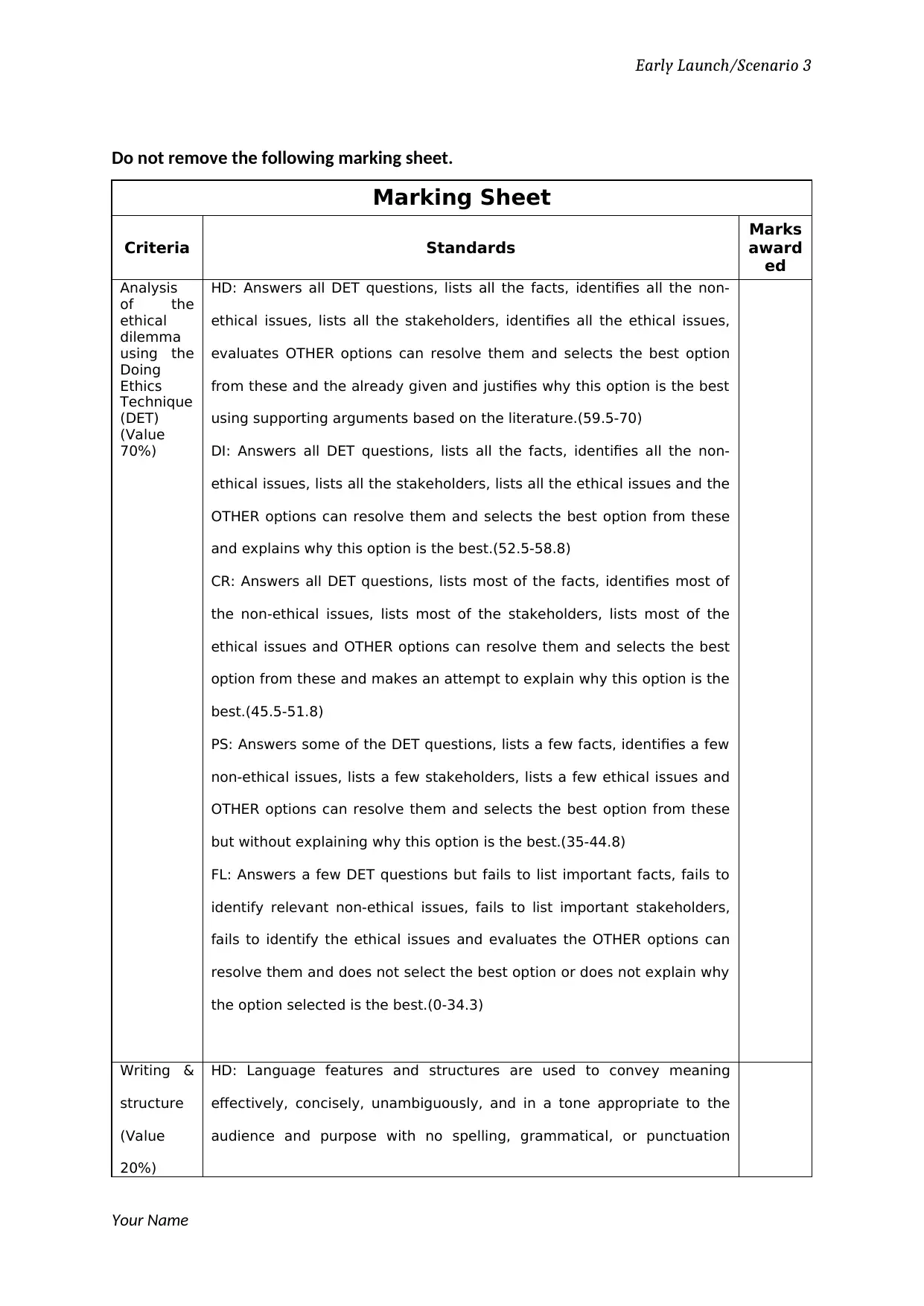
Early Launch/Scenario 3
Do not remove the following marking sheet.
Marking Sheet
Criteria Standards
Marks
award
ed
Analysis
of the
ethical
dilemma
using the
Doing
Ethics
Technique
(DET)
(Value
70%)
HD: Answers all DET questions, lists all the facts, identifies all the non-
ethical issues, lists all the stakeholders, identifies all the ethical issues,
evaluates OTHER options can resolve them and selects the best option
from these and the already given and justifies why this option is the best
using supporting arguments based on the literature.(59.5-70)
DI: Answers all DET questions, lists all the facts, identifies all the non-
ethical issues, lists all the stakeholders, lists all the ethical issues and the
OTHER options can resolve them and selects the best option from these
and explains why this option is the best.(52.5-58.8)
CR: Answers all DET questions, lists most of the facts, identifies most of
the non-ethical issues, lists most of the stakeholders, lists most of the
ethical issues and OTHER options can resolve them and selects the best
option from these and makes an attempt to explain why this option is the
best.(45.5-51.8)
PS: Answers some of the DET questions, lists a few facts, identifies a few
non-ethical issues, lists a few stakeholders, lists a few ethical issues and
OTHER options can resolve them and selects the best option from these
but without explaining why this option is the best.(35-44.8)
FL: Answers a few DET questions but fails to list important facts, fails to
identify relevant non-ethical issues, fails to list important stakeholders,
fails to identify the ethical issues and evaluates the OTHER options can
resolve them and does not select the best option or does not explain why
the option selected is the best.(0-34.3)
Writing &
structure
(Value
20%)
HD: Language features and structures are used to convey meaning
effectively, concisely, unambiguously, and in a tone appropriate to the
audience and purpose with no spelling, grammatical, or punctuation
Your Name
Do not remove the following marking sheet.
Marking Sheet
Criteria Standards
Marks
award
ed
Analysis
of the
ethical
dilemma
using the
Doing
Ethics
Technique
(DET)
(Value
70%)
HD: Answers all DET questions, lists all the facts, identifies all the non-
ethical issues, lists all the stakeholders, identifies all the ethical issues,
evaluates OTHER options can resolve them and selects the best option
from these and the already given and justifies why this option is the best
using supporting arguments based on the literature.(59.5-70)
DI: Answers all DET questions, lists all the facts, identifies all the non-
ethical issues, lists all the stakeholders, lists all the ethical issues and the
OTHER options can resolve them and selects the best option from these
and explains why this option is the best.(52.5-58.8)
CR: Answers all DET questions, lists most of the facts, identifies most of
the non-ethical issues, lists most of the stakeholders, lists most of the
ethical issues and OTHER options can resolve them and selects the best
option from these and makes an attempt to explain why this option is the
best.(45.5-51.8)
PS: Answers some of the DET questions, lists a few facts, identifies a few
non-ethical issues, lists a few stakeholders, lists a few ethical issues and
OTHER options can resolve them and selects the best option from these
but without explaining why this option is the best.(35-44.8)
FL: Answers a few DET questions but fails to list important facts, fails to
identify relevant non-ethical issues, fails to list important stakeholders,
fails to identify the ethical issues and evaluates the OTHER options can
resolve them and does not select the best option or does not explain why
the option selected is the best.(0-34.3)
Writing &
structure
(Value
20%)
HD: Language features and structures are used to convey meaning
effectively, concisely, unambiguously, and in a tone appropriate to the
audience and purpose with no spelling, grammatical, or punctuation
Your Name
⊘ This is a preview!⊘
Do you want full access?
Subscribe today to unlock all pages.

Trusted by 1+ million students worldwide
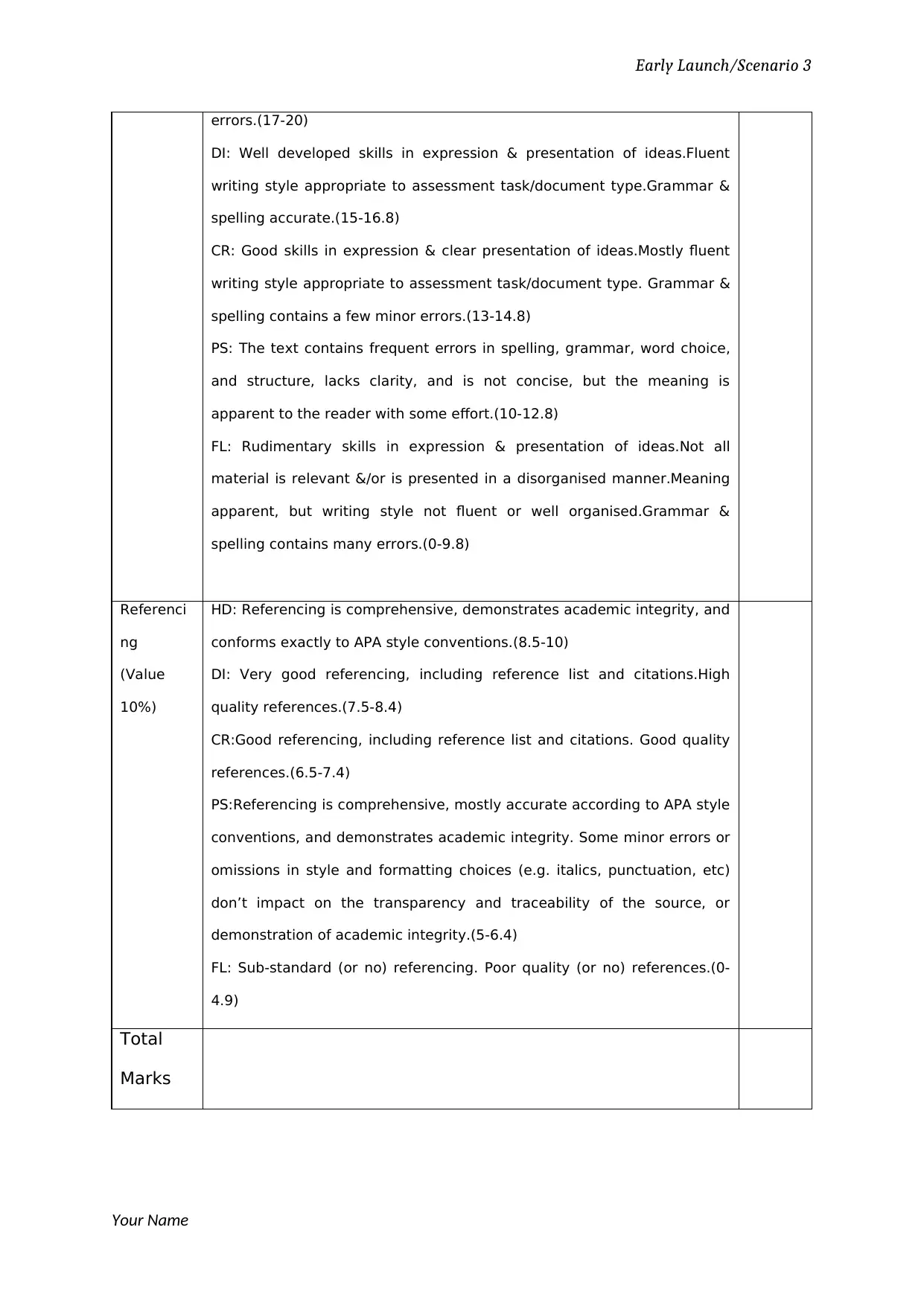
Early Launch/Scenario 3
errors.(17-20)
DI: Well developed skills in expression & presentation of ideas.Fluent
writing style appropriate to assessment task/document type.Grammar &
spelling accurate.(15-16.8)
CR: Good skills in expression & clear presentation of ideas.Mostly fluent
writing style appropriate to assessment task/document type. Grammar &
spelling contains a few minor errors.(13-14.8)
PS: The text contains frequent errors in spelling, grammar, word choice,
and structure, lacks clarity, and is not concise, but the meaning is
apparent to the reader with some effort.(10-12.8)
FL: Rudimentary skills in expression & presentation of ideas.Not all
material is relevant &/or is presented in a disorganised manner.Meaning
apparent, but writing style not fluent or well organised.Grammar &
spelling contains many errors.(0-9.8)
Referenci
ng
(Value
10%)
HD: Referencing is comprehensive, demonstrates academic integrity, and
conforms exactly to APA style conventions.(8.5-10)
DI: Very good referencing, including reference list and citations.High
quality references.(7.5-8.4)
CR:Good referencing, including reference list and citations. Good quality
references.(6.5-7.4)
PS:Referencing is comprehensive, mostly accurate according to APA style
conventions, and demonstrates academic integrity. Some minor errors or
omissions in style and formatting choices (e.g. italics, punctuation, etc)
don’t impact on the transparency and traceability of the source, or
demonstration of academic integrity.(5-6.4)
FL: Sub-standard (or no) referencing. Poor quality (or no) references.(0-
4.9)
Total
Marks
Your Name
errors.(17-20)
DI: Well developed skills in expression & presentation of ideas.Fluent
writing style appropriate to assessment task/document type.Grammar &
spelling accurate.(15-16.8)
CR: Good skills in expression & clear presentation of ideas.Mostly fluent
writing style appropriate to assessment task/document type. Grammar &
spelling contains a few minor errors.(13-14.8)
PS: The text contains frequent errors in spelling, grammar, word choice,
and structure, lacks clarity, and is not concise, but the meaning is
apparent to the reader with some effort.(10-12.8)
FL: Rudimentary skills in expression & presentation of ideas.Not all
material is relevant &/or is presented in a disorganised manner.Meaning
apparent, but writing style not fluent or well organised.Grammar &
spelling contains many errors.(0-9.8)
Referenci
ng
(Value
10%)
HD: Referencing is comprehensive, demonstrates academic integrity, and
conforms exactly to APA style conventions.(8.5-10)
DI: Very good referencing, including reference list and citations.High
quality references.(7.5-8.4)
CR:Good referencing, including reference list and citations. Good quality
references.(6.5-7.4)
PS:Referencing is comprehensive, mostly accurate according to APA style
conventions, and demonstrates academic integrity. Some minor errors or
omissions in style and formatting choices (e.g. italics, punctuation, etc)
don’t impact on the transparency and traceability of the source, or
demonstration of academic integrity.(5-6.4)
FL: Sub-standard (or no) referencing. Poor quality (or no) references.(0-
4.9)
Total
Marks
Your Name
1 out of 7
Related Documents
Your All-in-One AI-Powered Toolkit for Academic Success.
+13062052269
info@desklib.com
Available 24*7 on WhatsApp / Email
![[object Object]](/_next/static/media/star-bottom.7253800d.svg)
Unlock your academic potential
Copyright © 2020–2025 A2Z Services. All Rights Reserved. Developed and managed by ZUCOL.





